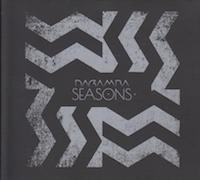The ensemble Zāle combine many elements in their music – from Latvian folk, to Eastern motifs to Gaelic elements, and their debut album, Viņa, released in 2015, received the Zelta Mikrofons award for Best World Music Album in 2015. The group released the follow up – appropriately entitled Viņš – at the end of 2016.
The core of the group remains Marta Kreituse on vocals and Pēteris Draguns on vocals and acoustic guitar, and they are joined by an ever-expanding group of musicians, including Sandra Kaņepe on vocals and electric guitar, Kira Maija Kirsanova on oboe, Aivis Gailītis on cello, Dace Zariņa on bass guitar, Harijs Vagrants playing the santir, and Taras Kuzmenko on percussion, as well as a few guest musicians.
Though the ensemble is large, the arrangements remain sparse and reserved, retaining the intimate nature of the songs from their first album. This is evident beginning with the first track on the album, “Aiz vārtiem”, based on a poem by Rainis. Draguns’ soothing, deep bass voice, along with the solemn, somber musical accompaniment, provides a template for the listener about the musical journey to come.
While the album Viņa had more Latvian folk elements in the music, Viņš takes a decided turn towards more world music elements, particularly Eastern sounds and melodies, such as in the song “Samarkanda”, which features Kreituse’s mystical vocals balanced with the strings and oboe, to create a dreamy effect for the song.
With a nod to the group’s various world music influences, particularly the Celtic sounds, the group also recorded a version of the Irish folk song “My Young Love” (also known as “She Moved Through the Fair”), and it is a natural fit for Kreituse’s voice and performance. The ensemble bring the necessary restraint in their lush arrangement for this sorrowful song, making for one of the most memorable performances on the album.
The album does have a few relatively up-tempo moments, such as in the song “Vantis”, a song about a journey over the Vanšu Bridge in Riga, described in philosophical and metaphorical images. The song’s driving beat and rhythm is supplemented by the hip hop stylings of Jacques of S’T’A.
The album’s title Viņš (He) would seem to indicate that this album would be a more ‘masculine’ album, implying perhaps more up-tempo and active songs, to balance out the softer, emotional songs on the album Viņa (She), but this is not always the case. Perhaps the titles were simply meant to indicate that the albums are two sides of the same coin, as there are many similar elements between the two.
Viņš is a satisfying follow-up to Viņa, as the group builds upon the themes of their debut album, adding additional instruments and more nuanced arrangements, seamlessly weaving together many different styles and genres, making Viņš an engrossing listen from beginning to end. With their ethereal, entrancing sound, Zāle have established themselves as a creative and artistic force in Latvian music.
For further information, please visit Zāle’s Facebook page.
Viņš
Zāle
Kultūras Inovāciju Centrs, 2016
Track listing:
-
-
- Aiz vārtiem
- Samarkanda
- Meitene – noslēpums
- Ūdens daļa
- Kiss Me
- Vantis
- Tumša upe
- Skumju zvēri
- Cik sapņa izmodos
- My Young Love
- Dziļi dziļi
-




